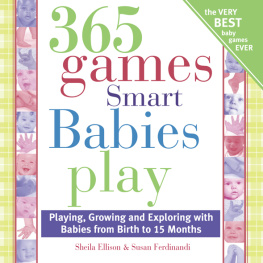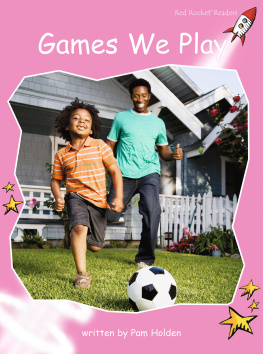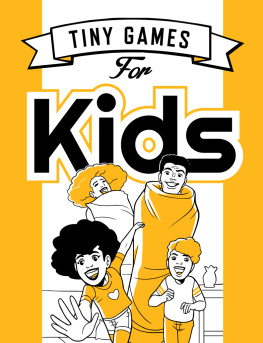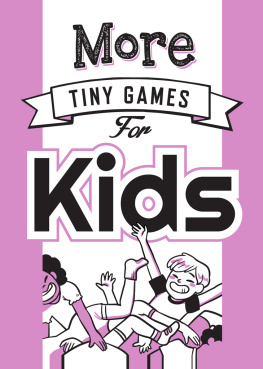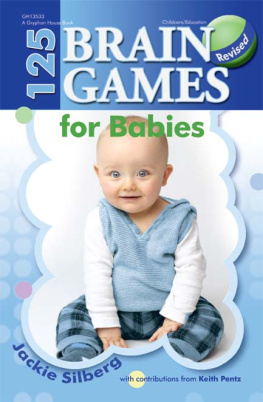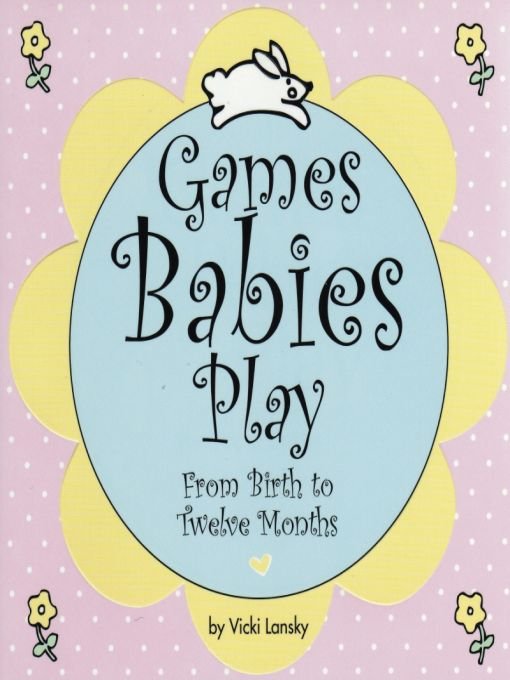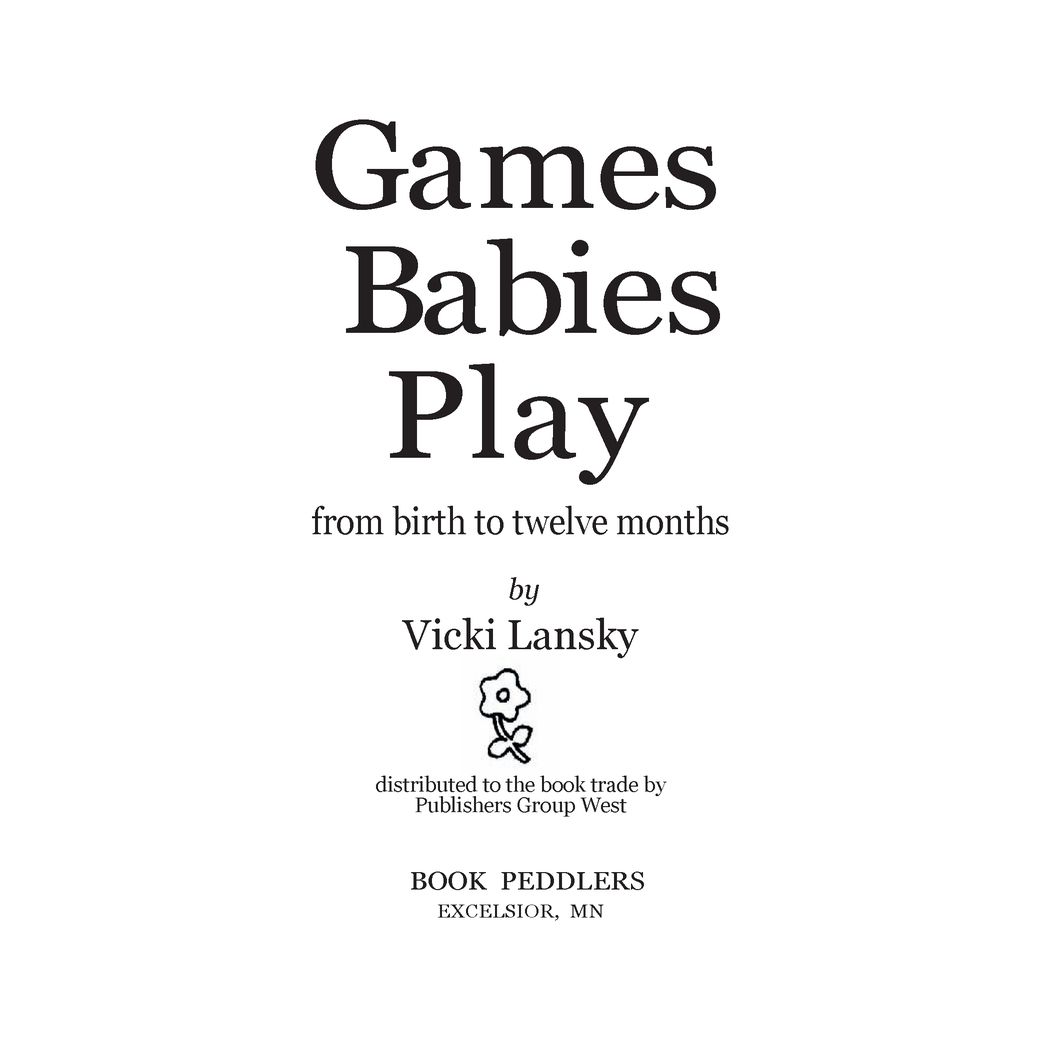Table of Contents
special thanks to:
editors: Cynthia Stange, Kathryn Ring, Carol Lowry, and contributors: David Katzner, Jean Ruchert, Terri Ellis, Betsy Koch, Rhonda Koziak, Sharon Peterson, Stacy and Roy Haslett.
introduction
Welcome to the wonderful world of your baby.
In this first year you will see your babys abilities expand as your little one grows and develops in amazing ways. There is no way more wonderful to share in this process than through the delight of play and games.
In baby play each family member learns about the otherand about oneself. You learn about attention spans, abilities, communication without words, patience, anticipation, crescendos, beginnings and endings, laughter, and the joy of touching.
And best of all, in playing games, a baby learns that he or she is loved.
Babies collect information through their senses. They need to have stimulation brought to themstimulation to match their growing abilities. Here are activities to encourage as well as delight.
While these ideas are given in a loose chronological order, dont forget to go back and play the games suggested in the earlier chapters as your baby matures.
With all the newly developing skills that these games will help encourage, know that this is only the beginning. The best is yet to come.
Enjoy!
Vicki Lansky
Developmental Milestones
birth to 3 months
Babies are a miracle of sensory development. Their eyes focus well only at around eight inches for the first month of life. Still, this allows them to concentrate on whats most importantstudying their parents faces and the faces of those who feed and care for them. Newborns also respond to bright colors, bright lights and objects put near their faces.
Infants hearing is comparable to that of adults. In fact, soon after birth, infants have been shown to prefer music they heard while in utero. They can be startled by sudden, loud noises. Newborns sense of smell is developed enough for them to be able to identify their mothers smell.
In the first three months, a babys energy is devoted to self-regulation in the areas of eating and sleeping. Still, they take in any information that acts upon them. Body movement is at first random and erratic. But each passing week brings more interaction with the environment, more smiling, and more control of those tiny hands which wave in front of babys own face.
Neck muscles are not strong enough to support the head adequately so your help is needed for the first few months. A hand will grasp an object placed in the palm, though it is only a reflex action.
By the third month, babies have become social beings, eager to smile, clearly recognizing familiar people, and delighted with attention. You can build a foundation of special, shared times by relating through games played together.
BIRTH TO 3 MONTHS
All Washed Up
Baby Firming
Baby Parts
Baby Pull-Ups
Bathtub Time-Out
Bed Bouncing Baby
Dance with Me, Baby
Exercycle
Finger Games
Im Gonna Getcha!
Look at Me
Lost in Space
Lullaby Your Baby
Old World Traditions
Parent A Cappella
Playback
Pom Pom Play
Puppet Play
Rattles
Starburst
Stretchy, Stretchy
Strokes for Lil Folks
Tickle Time Rhymes
The Tootsie Roll
Toy Target Practice
Who Do I See?
Wrist Watch
ALL WASHED UP
Talk and sing while bathing your infant in a sink or plastic molded tub. Sing about the parts of the body youre washing. The following can be sung to London Bridge Is Falling Down.
Head, Shoulders, Knees and Toes
Head and shoulders, knees and toes,
Knees and toes, knees and toes.
Head and shoulders, knees and toes,
Eyes and ears and mouth and nose.
Sing this to the tune of Here We Go Round the Mulberry Bush.
This Is the Way We Wash Our Face
This is the way we wash our face,
Wash our face, wash our face.
This is the way we wash our face
On a (day of the week) (morning or evening).
Other verses to include in your bath time routine are:
clean our toes,
wash our arms,
scrub our feet,
this list is endless.
These songs go well beyond infancy and will take on many variations as your baby learns the parts of the body.
BABY FIRMING
Your little one can help you get back in shape and make it more fun. Once your doctor okays you resuming exercise, there are firming-up routines you can begin that can include and entertain your baby.
Kissy-Kissies
With your baby lying face up on the floor, get on all fours over your baby with your baby between your hands. Begin gently by just lowering your head to kiss your little one. Advance to lowering your straightened bodywith your weight resting on your knees and hands angled slightly inwarddown to kiss your baby. Dont let your stomach sag or your back arch. Push back up and repeat. If you were able to do standard push-ups before you were pregnant, work gently back to this stage without straining yourself. If you dont like push-ups, limit yourself to cat curls where you just arch your back and then relax it again.
Better Bottoms
Lie on your back with your knees bent, feet on the floor, and baby sitting on your stomach with your hands securely around the torso under his or her arms. Squeeze your buttocks tightly together and raise your hip bones upward and hold for one or two seconds. Release and lower. Next flatten the small of your back to the floor and curl your head and upper body up while keeping your back straight on the floor. Release and lie back. Alternate these two routines to build up back and abdomen strength.
BABY PARTS
Your babys body parts will provide the topic for many of the conversations the two of you will carry on as you interact. Youll find your newborn is not much of a conversationalistmost of the burden of small talk will fall to you. Your repetition of such words as nose, eyes, fingers, chin, and ears will start your baby on a lifelong learning process.
Knock, Knock
Knock, knock. (Knock on babys forehead.)
Peek in. (Open eyes wider.)
Open the latch. (Push up the tip of the nose.)
And walk right in. (Walk fingers into mouth.)
How do you do, Ms. Chin-chin-chin? (Wiggle chin.)
Thumbkin, Pointer
Thumbkin, pointer, middleman big.
(Point to each of babys fingers.)
Silly man, wee man, rig-a-jig-jig.
(Roll babys hands around each other.)
Months from now, when your baby becomes well-versed in the names of the body parts, you can purposely slip in a wrong word or two so he or she can correct you.
BABY PULL-UPS
When your baby is two or three months old and can raise and hold up his or her head, you can begin a wider range of games.
Infant Sit-ups
Lay your baby on the floor (or bed) in front of you, or in your lap facing you. Gently pull the baby up to a sitting position, while holding hands. Say something like, U-u-up you go, or Baby sits up now. (When you pull a two month old to a sitting position, the babys head may still lag a bit.)


